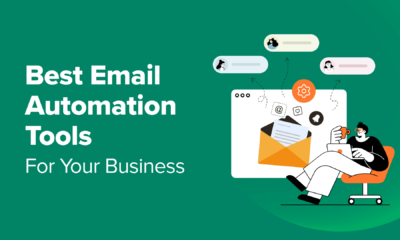MARKETING
How Learning Python Can Improve Your PPC Campaigns
Python has a major focus in SEO but what about PPC? The two disciplines are often treated as polar opposites but they share common goals and adding a bit of Python to a PPC campaign can do wonders for improving conversions, CTR, and time spent.
But before we have a look at how Python can boost your PPC performance, we need to outline what the language is all about.
What is Python?
Python is a programming language created by Guido van Rossum in the 1980s and publicly released in 1991. van Rossum wanted Python to emphasize code readability with five philosophical pillars:
- Beautiful is better than ugly
- Explicit is better than implicit
- Simple is better than complex
- Complex is better than complicated
- Readability counts
Its structure and syntax help users to write logical code regardless of project size.
Companies that use Python include Google (naturally), Netflix, YouTube, NASA, IBM, Mozilla, and Disney.
Is it easy to learn?
The entry-level for Python is very low. Everything is based on logic and the language shares a lot of its syntax with other well-known languages such as JavaScript and C++. And if there isn’t a function that can solve your problem, you can create your own.
How do I install it?
As Jacob Fairclough said, Python can be difficult to install for some users. But that depends on your operating system.
For most Mac users, Python comes built-in so you can use your Terminal to access it. That’s not the case for Windows users. The recommended way is via Anaconda as this also installs a lot of useful libraries to use (which I’ll explain in more detail later).
Google has its own environment as well called Google Colab.
Python techniques to help your PPC campaigns
In the words of Aristotle, “for the things we have to learn before we can do them, we learn by doing them”. And Python is no exception. Practicing Python in SEO is common practice and it’s the same for PPC.
Understanding other languages is important but Python can save professionals a lot of time by automating jobs that would normally take hours.
The amount of data you can obtain from a PPC campaign can grow very quickly so a way to organize and automate it into a logical structure would make everyone’s lives a lot easier in the long run.
Two of the biggest applications of Python are AI and machine learning and they’re also the main bridges between the language and PPC. As Danielle Strouther said in her article AI For PPC Is Only Useful If You Use External Tools, “using AI for PPC is no longer an option. It’s a necessity.” So that’s what we’ll look at – integrating Python with external tools and software.
Other things you can do with Python that can help you with PPC management includes:
- Data scraping
- Data analysis and mining
- Data visualization
- Natural language processing (NLP)
Python + Google Ads
We all know how laborious Google Ads management can be. So Google created an API for its ad platform so users can automate a wide range of PPC-related tasks. You can find a list of them on the Client Library page.
One programmer created a script for KPI reporting which would come in handy for clients, shareholders, and colleagues.
Python + Google Search Console
When you write PPC ads, you want them to convert so your ROI can be as high as possible. Search data from Search Console can help find areas to improve or examples of success to capitalize on.
Passion Digital created a script that analyses search queries from Search Console to gain insights to improve SEO and PPC performance. It does this by finding keywords and phrases with poor conversion rates and CPA using those terms.
Python + Excel/Google Sheets
One of the most common Python workflow combos involves Excel and Google Sheets.
As data can be exported as CSV files and spreadsheets by most external tools, it’s easy to import them into a spreadsheet program. And Python loves data.
The list of ways to use Python and Excel with PPC data is exhaustive. You could use it to project future trends, CTR prediction, campaign creation, keyword generation, bid modifying, account structure analysis, customer match lists, geolocation targeting.
Python + Google Data Studio
Google Data Studio is a powerful tool for data visualization and it’s free to use. So combining it with Python means a streamlined approach to data viz and reporting.
There are also paid tools like Panoply which can integrate Data Studio and Python along with a multitude of services like Salesforce, Zendesk, and Google Analytics. Suddenly you have a large network of data from every department – sales, dev, customer support, project management, design, web analytics. Phew!
You can even spy on your competitors using Python and create PPC reports and graphs with Data Studio to show the results.
Python + Google
The SERPs are more than just a display of results. They can be used as their own data source and give an insight into how well you and your competitors are doing.
With APIs like Serpstack, you can extract data about ads from any SERP and analyze things like position, title and description optimization, sitelinks, and displayed URLs. You can also leverage this with organic results to find new potential keywords you can bid on and improve your campaigns.
Python + Facebook
In 2017, Facebook made its Prophet open source. The forecasting tool is accessible through Python and R (another programming language) and is optimized for businesses to forecast trends, whether they’re hourly, daily, weekly, or seasonal.
It’s highly advanced and mainly for large scale business use but if you have the expertise and the resources, Prophet has the potential to streamline major paid campaigns.
Useful libraries, modules, and APIs
Vanilla Python can do most jobs but its power lies in all the libraries, modules and APIs you can use. Although they all share similarities, they’re all different additions. A module is a Python file containing functions, variables, and methods, a library is a collection of modules and pre-defined functions that let you perform actions without writing the code yourself, while an API is an interface set of standards and instructions.
Here’s a list of some useful ones you can use.
- Pandas (library) – Pandas is an open-source library that makes data structures and data analysis tools. You can make tables, create ordered and unordered data series and “dataframes”, join, merge, and split them. It’s probably the most flexible data analysis tool to have if you’re using Python.
- CSV (module) – This module goes hand-in-hand with pandas as it allows you to export data into a CSV.
- Requests (library) – Requests is a must if you’re scraping web data. It sends requests to HTTP pages, allowing you access to pull anything from a webpage. If you’re planning to scrape SERP data, it’s an essential library to use.
- Beautiful Soup (library) – Beautiful Soup is the companion to requests, letting you take out everything inside an HTTP page.
- Serpstack (API) – The serpstack API allows you to scrape Google SERP data in real-time and at scale and it lets you export the data in JSON and CSV formats (depending on your account level).
- Google APIs (API) – Google being Google, they have a library of APIs you can use for all kinds of things.
- TensorFlow (library) – One of the best libraries for machine learning.
- SciKit Learn (library) – Another machine learning library for predictive data analysis
Other resources
Summary
Learning a programming language can seem daunting but Python is one of the easiest and most accessible languages out there. Its automation and analysis capabilities have a wide range of uses and it can help to simplify complex data and automate time-consuming tasks. Nobody wants to make their jobs harder!
If I had to give some takeaway advice to remember while you learn, I’d say:
Don’t let FOMO get to you
When I started learning Python, I got carried away with jumping into projects without knowing all the techniques. Everyone on Twitter was making amazing scripts and I was still learning about lists and loops. But then I realized I was never going to get to their level by copying and pasting when I didn’t understand. So I went back to my course and focused solely on that.
Fully understanding the basics is the only way you’ll be able to build up to the advanced techniques. And there’s no expiration date on education.
Practice, practice, practice
Most courses come with practice examples. Aside from those, you should always test what you’ve learned. It doesn’t have to be part of a big project, just something small so you can get the hang of the techniques.
Stay curious
Learning something new isn’t always easy. You’ll get frustrated when things don’t work and you may need some time away if it gets too much. But never lose your curiosity. Programming languages have so many applications and some haven’t even been discovered yet. Stay curious and you might find one.
Find others who are learning
Communities are great places to improve your learning. Here are some great places to collaborate and grow with Python:
Sign up to the Python Weekly newsletter


















